Last Updated on 4 months by Francis
When it comes to caring for sugar gliders, temperature control is a crucial aspect. These small, adorable creatures require specific heat conditions to thrive and stay healthy. In this article, we’ll explore the importance of infrared heaters for sugar gliders and how to ensure their safety in their warm habitats.
Sugar gliders have a temperature range of 65 – 90 degrees Fahrenheit for optimal comfort. It’s essential to maintain this range to prevent any adverse effects on their health. Baby sugar gliders have even more delicate needs and should be kept at a regulated range of 78-80 degrees year-round. Breeding sugar gliders also require controlled temperatures between 70-85 degrees. If you’re relocating your sugar gliders, temperature considerations become even more critical.
Understanding sugar glider body temperature is key to providing suitable heating options. Their body temperature is similar to that of humans. So, if a temperature feels comfortable for us, it’s usually suitable for sugar gliders as well. It’s important to note that baby sugar gliders require warmer temperatures and should be acclimated slowly to their new environment. In contrast, breeding sugar gliders have a higher tolerance for warmer temperatures.
Contents
Key Takeaways:
- Temperature control is crucial for the well-being of sugar gliders.
- Sugar gliders require a specific temperature range of 65 – 90 degrees Fahrenheit.
- Baby sugar gliders require warmer temperatures, while breeding sugar gliders have a higher tolerance for warmth.
- Understanding sugar glider body temperature helps in providing suitable heating options.
- Acclimate baby sugar gliders slowly to new environments with warmer temperatures.
Understanding Sugar Glider Body Temperature
Sugar gliders, like humans, have a body temperature that needs to be regulated for their well-being. Understanding their body temperature is crucial for effective temperature control in their environment. Let’s explore the details.
Sugar Glider Body Temperature
Sugar gliders have a body temperature similar to that of humans. This means that if a temperature feels comfortable to humans, it is usually suitable for sugar gliders as well. Maintaining the right temperature is essential for their health and overall happiness.
Temperature Differences Based on Age
It’s important to note that baby sugar gliders have specific temperature requirements. They need warmer temperatures to thrive properly. When introducing baby sugar gliders to a new home, it’s crucial to acclimate them slowly to the temperature of their surroundings. Gradual adjustments help them adapt and ensure their well-being.
On the other hand, breeding sugar gliders have a higher tolerance for warmer temperatures compared to adults. Their bodies can handle slightly higher temperatures without any discomfort. It’s important to consider these differences when creating a suitable habitat for your sugar gliders.
Ensuring Proper Temperature Control
To provide an optimal environment for sugar gliders, it’s crucial to maintain temperature control. Consider their specific temperature needs based on age and provide a consistent and comfortable environment.
“To keep your sugar gliders happy and healthy, ensure the ambient temperature falls within the appropriate range for their specific needs.”
By monitoring and adjusting the temperature, you can create a comfortable space for your sugar gliders to thrive. Remember, their well-being depends on your attention to temperature control.
Heating Options for Sugar Gliders

When it comes to keeping your sugar gliders warm and comfortable, choosing the right heating option is crucial. There are several options available, including heating pads, ceramic heat lamps, and infrared heat lamps. Each option has its advantages and considerations, so let’s take a closer look at these heating options.
Heating Pads
Heating pads are a popular choice for providing consistent warmth to sugar gliders. These pads are designed to be placed beneath the cage or inside a designated area, such as a nesting box. They deliver a gentle and even heat that mimics the warmth of a sugar glider’s mother pouch.
When using heating pads, it’s important to choose models specifically designed for small animals and ensure they have a built-in temperature control feature. This helps prevent overheating and ensures the pad is always at an optimal temperature for your sugar gliders’ comfort.
Ceramic Heat Lamps
Ceramic heat lamps are another reliable option for heating sugar glider habitats. These lamps emit heat through a ceramic element and can be suspended or placed on a stand outside the cage. Ceramic heat lamps are known for providing steady and long-lasting warmth.
When using ceramic heat lamps, it’s essential to keep them securely positioned and out of reach of the sugar gliders. Additionally, it’s crucial to monitor the temperature regularly and ensure it stays within the recommended range for sugar gliders.
Infrared Heat Lamps
Infrared heat lamps are an innovative heating option for sugar gliders. These lamps emit infrared radiation, which directly warms the objects and animals in their immediate vicinity. Infrared heat lamps are energy-efficient and produce a gentle, radiant heat that is beneficial for sugar gliders.
It’s important to choose infrared heat lamps that are specifically designed for animals, as they emit safe and controlled levels of heat. These lamps should be positioned outside the cage, ensuring that the sugar gliders have a comfortable distance from the heat source.
Here is a table summarizing the pros and cons of each heating option:
| Heating Option | Pros | Cons |
|---|---|---|
| Heating Pads | Provide consistent warmth; mimic natural heat | May require additional monitoring; can’t be directly controlled |
| Ceramic Heat Lamps | Steady and long-lasting warmth; adjustable settings | Requires proper positioning; can be a potential burn hazard |
| Infrared Heat Lamps | Energy-efficient; gentle radiant heat; safe for sugar gliders | Requires proper positioning; limited heat control |
Choose the heating option that best suits your sugar gliders’ needs and consider factors such as cage size, ambient temperature, and personal preference. Remember to always prioritize their safety and comfort when providing supplemental heating.
Avoiding Heat Lamp Use for Sugar Gliders
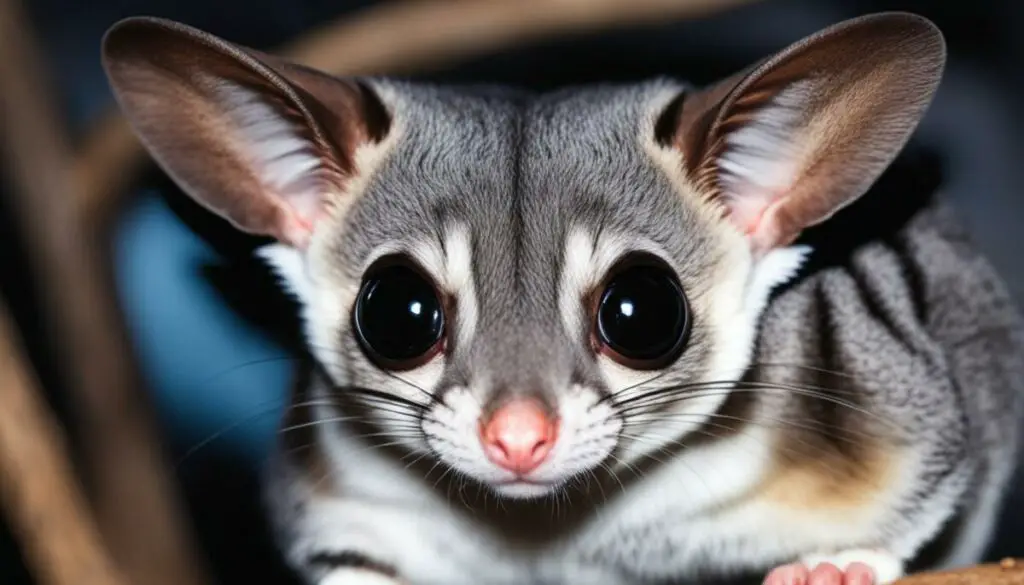
Sugar gliders are unique creatures that require specific care and environmental conditions to thrive. When it comes to providing warmth for sugar gliders, it’s important to be aware of the dangers of heat lamps and the potential risks they pose. Heat lamps should not be used for sugar gliders, as they can easily overheat or get burnt due to the intense heat they emit.
Sugar gliders have the ability to regulate their body temperature in various climate conditions. Their natural fur coat provides insulation, and they can curl up and nestle into warm places to keep themselves comfortable. Instead of relying on heat lamps, there are alternative methods to ensure that your sugar gliders stay warm and cozy.
Provide Plenty of Fleece Blankets
Fleece blankets are an excellent way to provide warmth for your sugar gliders. They are soft, cozy, and easy to clean. Place several fleece blankets in their enclosure, allowing them to snuggle up and nestle into the fabric. The fleece blankets will retain their body heat and provide a comfortable environment for them to sleep and rest. Ensure that the fleece blankets are clean and free from any loose threads or potential hazards that could pose a risk to your sugar gliders.
Offer a Warm Pouch or Box
In addition to fleece blankets, providing a warm pouch or box for your sugar gliders can also help maintain a suitable temperature. Sugar gliders enjoy sleeping in enclosed spaces, mimicking their natural nesting behavior. A warm pouch or box lined with fleece or other soft materials can serve as a cozy haven for them to retreat to when they need extra warmth. Make sure the pouch or box is secure and well-ventilated to ensure their safety.
By avoiding the use of heat lamps and instead focusing on providing plenty of fleece blankets and a warm pouch or box, you can create a comfortable and safe environment for your sugar gliders without exposing them to the potential dangers associated with heat lamps.
Remember, the well-being of your sugar gliders should always be the top priority. With the right care and attention, you can ensure that they thrive in a warm and nurturing environment.
Nocturnal Infrared Lighting System for Sugar Gliders
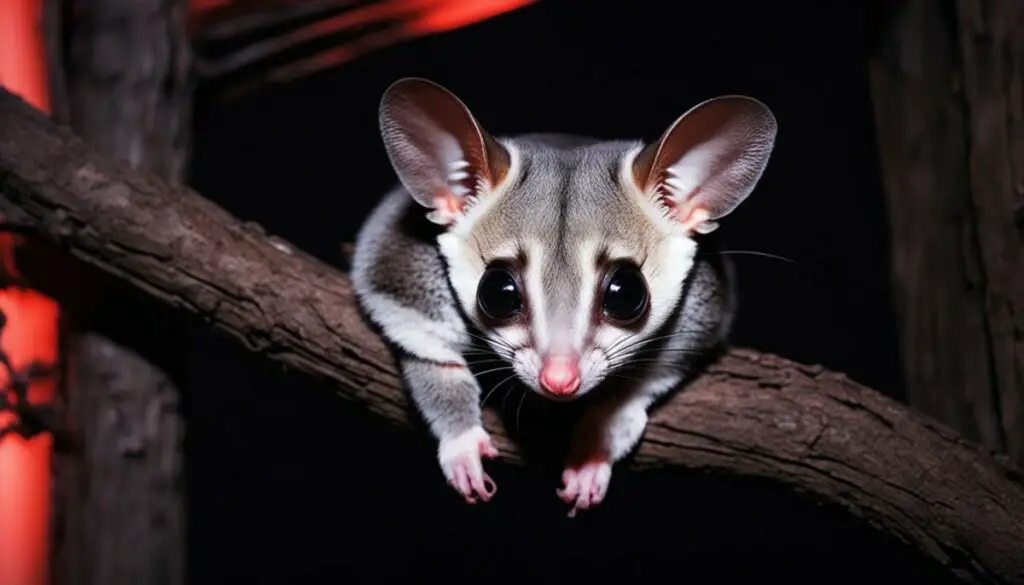
A nocturnal infrared lighting system is an essential component for providing the right level of heating and lighting for sugar gliders. This system offers a 24-hour non-disturbing light and heat source, ensuring the well-being of your sugar gliders, especially during their active nighttime hours.
The nocturnal infrared lighting system creates a natural and comfortable environment that mimics the sugar gliders’ natural habitat. This is crucial for the overall health and happiness of these nocturnal creatures.
The main components of a nocturnal infrared lighting system are the clamp lamp and bulb. The clamp lamp is securely attached to the exterior of the sugar glider’s cage or terrarium, providing a safe and effective lighting solution. The bulb emits infrared light, which allows crepuscular and nocturnal animals, like sugar gliders, to navigate and explore their habitat during the night.
The nocturnal infrared lighting system offers numerous benefits for sugar gliders:
- Non-disturbing light: The infrared light emitted by the bulb is invisible to the naked human eye, ensuring that the sugar gliders are not disturbed while they sleep and explore their surroundings.
- Proper temperature regulation: The heating element of the bulb provides a consistent and gentle heat source, maintaining the ideal temperature range for sugar gliders.
- Mimics natural lighting conditions: The infrared light replicates the gentle glow of moonlight, creating a soothing and calming atmosphere for sugar gliders.
- Safe and efficient: The system is designed with safety in mind, ensuring that the sugar gliders are not exposed to any harmful substances or excessive heat.
By incorporating a nocturnal infrared lighting system into your sugar glider’s habitat, you are providing them with the optimal conditions for their well-being and comfort. It ensures their natural instincts are met while keeping them warm and secure throughout the night.
Proper Setup and Usage of Nocturnal Infrared Lighting System

When it comes to creating a safe and comfortable environment for your sugar gliders, proper setup and usage of a nocturnal infrared lighting system is essential. By following a few key steps, you can ensure that your sugar gliders have access to the right amount of light and heat without any risks.
Securely Clamp, Hang, or Mount the Lamp
To begin, it is important to securely attach the nocturnal infrared lamp to the sugar glider’s cage or terrarium. Use a clamp, hanger, or mount specifically designed for this purpose. By doing so, you can prevent any accidental falls or disturbances to the sugar gliders.
Keep the Lamp Outside the Cage or Terrarium
One crucial safety measure is to ensure that the lamp is always placed outside the sugar glider’s cage or terrarium. This prevents any direct contact with the lamp or its components, minimizing the risk of burns or injuries to the sugar gliders.
Choose the Right Bulb or Ceramic Heater
When selecting a bulb or ceramic heater for the nocturnal infrared lighting system, it is important to consider the wattage. Choose a bulb or heater that does not exceed 75 watts to avoid overheating the sugar glider’s habitat. This allows for optimal temperature control without posing any harm to the sugar gliders.
Ensure Lamp Safety
Prior to setup, ensure that the lamp is unplugged and turned off. This prevents any accidental electrical shocks or malfunctions during the installation process. Once the lamp is securely in place, you can plug it in and turn it on, providing your sugar gliders with the necessary light and heat.
With the nocturnal infrared lighting system properly set up and maintained, your sugar gliders can enjoy a comfortable and well-lit environment throughout their sleep cycles. This system allows for natural navigation in their habitat while fulfilling their nocturnal needs.
Temperature Control and Safety Precautions

Proper temperature control is crucial for ensuring the safety and well-being of sugar gliders. These small marsupials are native to a warm climate and require specific temperature conditions to thrive. In this section, we will explore important safety precautions and strategies for effectively controlling the temperature in your sugar glider’s environment.
Avoid Using Heat Lamps or Heat Rocks
While it may be tempting to use heat lamps or heat rocks to provide warmth for your sugar gliders, it is best to avoid them. Heat lamps can easily overheat the cage, potentially leading to burns or even fires. Heat rocks can also become dangerously hot and cause injury to the gliders. It is important to prioritize their safety by using alternative heating methods.
Maintain a Warm Environment
Instead of relying on heat lamps or heat rocks, consider using double fleece pouches and small fleece blankets to create a warm and cozy environment for your sugar gliders. These pouches and blankets provide insulation and help retain heat, ensuring that your gliders stay comfortable even in colder climates. Regularly check and adjust the temperature to ensure it remains within the optimal range for sugar gliders.
Monitor for Signs of Overheating
It is essential to regularly monitor your sugar gliders for any signs of overheating or discomfort. Some common signs include excessive panting, lethargy, loss of appetite, and rapid breathing. If you notice any of these symptoms, it may indicate that the temperature is too hot for your gliders. Take immediate action to lower the temperature and ensure their well-being.
Temperature Guidelines for Sugar Gliders
| Life Stage | Temperature Range (Fahrenheit) |
|---|---|
| Adult Sugar Gliders | 65-90 |
| Baby Sugar Gliders | 78-80 (year-round) |
| Breeding Sugar Gliders | 70-85 |
By following these temperature control strategies and safety precautions, you can ensure that your sugar gliders are comfortable and protected. Remember, providing a warm and cozy environment is essential for their overall well-being and happiness.
Outdoor Housing Considerations for Sugar Gliders
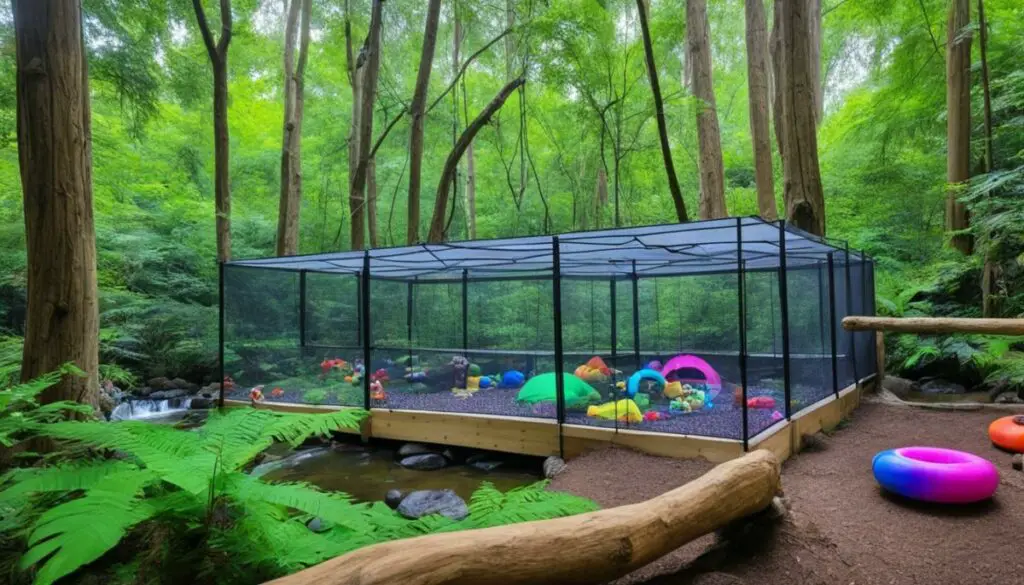
When it comes to providing outdoor housing for sugar gliders, there are a few important factors to consider. Not all climates are suitable for keeping sugar gliders outdoors, so it’s crucial to assess the temperature fluctuations and potential risks from predators and other animals. Creating a safe and secure environment for your sugar gliders is paramount.
To ensure the well-being of your sugar gliders in outdoor housing, temperature control is key. Extreme weather conditions can be detrimental to their health, so it’s crucial to protect them from temperature fluctuations. Consider the following temperature considerations when setting up outdoor housing for your sugar gliders:
- Temperature Range: Make sure the outdoor temperatures fall within the suitable range for sugar gliders. The ideal temperature range for sugar gliders is typically between 65 and 90 degrees Fahrenheit.
- Shade and Shelters: Provide ample shade and shelter options within the outdoor housing area. This will offer protection from direct sunlight and extreme weather conditions.
- Insulation: Insulate the outdoor housing to regulate temperature. The insulation materials used should be safe for sugar gliders and capable of maintaining a stable and comfortable temperature.
- Monitoring: Regularly monitor the temperature in the outdoor housing to detect any sudden fluctuations or extreme temperatures. Implement a temperature control system to ensure your sugar gliders are always kept in a safe and suitable environment.
Remember to consult with a veterinarian or an experienced sugar glider owner before moving your gliders to outdoor housing. They can provide valuable guidance and recommendations specific to your gliders’ needs.
Ensure that the outdoor housing meets the necessary safety standards and protects your sugar gliders from potential predators. Their safety should be the top priority.
Take a look at the table below for a quick overview of the temperature considerations for outdoor sugar glider housing:
| Temperature Considerations for Outdoor Sugar Glider Housing | |
|---|---|
| Suitable temperature range | 65 – 90°F |
| Shade and shelter options | Providing ample shade and shelters |
| Insulation | Using safe materials and ensuring proper insulation |
| Monitoring | Regular temperature monitoring and control system |
Creating suitable outdoor housing for your sugar gliders can provide them with a stimulating and natural environment. However, it’s important to remember that outdoor housing may not be suitable or safe for all sugar gliders or in all climates. It’s essential to consider the temperature fluctuations, potential risks, and consult with experts to ensure the well-being and safety of your sugar gliders.
Indoor Housing and Temperature Control
Creating a suitable indoor housing environment is crucial for the well-being of sugar gliders. Proper temperature control plays a significant role in ensuring their comfort and overall health. Here are some essential considerations for maintaining the ideal temperature:
Room Temperature
Start by ensuring that the room where the sugar gliders are kept maintains a suitable temperature range. The recommended temperature range for sugar gliders is between 65 to 90 degrees Fahrenheit (18 to 32 degrees Celsius). This range provides a comfortable environment for them to thrive.
Heating Options
To provide warmth during colder temperatures, you can use heating options such as heating pads or infrared heat lamps. Heating pads are a safe and effective choice, as they offer consistent heat distribution. Infrared heat lamps can also be used, but it’s important to monitor the temperature closely to prevent overheating.
Temperature Monitoring
Regularly monitoring the temperature in the indoor environment is crucial for the well-being of sugar gliders. Use a reliable thermometer to ensure that the temperature remains within the recommended range. Make adjustments to the heating options as necessary to maintain a comfortable temperature for your sugar gliders.
By creating an indoor housing environment with proper temperature control, you can ensure that your sugar gliders are happy and healthy.
| Heating Options | Advantages | Disadvantages |
|---|---|---|
| Heating Pads | – Provides consistent heat distribution – Safe for sugar gliders |
– May require frequent replacement – Limited heat range |
| Infrared Heat Lamps | – Can provide targeted heat – Versatile placement options |
– Requires closer temperature monitoring – Potential risk of overheating |
Conclusion
In conclusion, ensuring the safety and well-being of sugar gliders requires careful temperature control. Using suitable heating options such as heating pads, ceramic heat lamps, or infrared heat lamps is essential in maintaining the ideal temperature range for these adorable creatures. It is important to avoid the use of heat lamps or heat rocks, as these can pose potential dangers and harm to sugar gliders.
Regular monitoring of the temperature in the sugar glider’s environment is crucial to create a comfortable habitat. By providing a warm and cozy atmosphere with the right heating source, sugar gliders can thrive and remain healthy.
Remember, your sugar glider’s safety should always be a top priority. By following these guidelines and ensuring proper temperature control, you can create an environment that promotes the well-being and happiness of your sugar gliders. So, make sure to choose the appropriate heating option and regularly check the temperature to provide a safe and comfortable home for your furry friends.
FAQ
Can I use an infrared heater for my sugar gliders?
Yes, an infrared heater can be used to provide warmth for your sugar gliders. However, it is important to follow proper safety guidelines and temperature control to ensure their well-being.
What temperature range do sugar gliders require?
Sugar gliders require temperatures of 65 – 90 degrees Fahrenheit. Baby sugar gliders should be kept in a regulated range of 78-80 degrees year-round, while breeding sugar gliders are kept at controlled temperatures of 70-85 degrees.
What are the heating options for sugar gliders?
Heating options for sugar gliders include heating pads, ceramic heat lamps, and infrared heat lamps. These options can help maintain a suitable temperature in their environment.
Why should I avoid using heat lamps for sugar gliders?
Heat lamps should not be used for sugar gliders as they can easily overheat or cause burns. Sugar gliders can regulate their body temperature in various climate conditions, so providing proper bedding and insulation is usually sufficient.
What is a nocturnal infrared lighting system for sugar gliders?
A nocturnal infrared lighting system is a 24-hour non-disturbing light and heat source designed for crepuscular and nocturnal animals like sugar gliders. It includes a clamp lamp and bulb that can be attached to the exterior of the sugar glider’s cage or terrarium.
How do I set up and use a nocturnal infrared lighting system for sugar gliders?
Securely clamp, hang, or mount the lamp at one end of the sugar glider’s cage or terrarium. Never place the lamp inside the cage or terrarium. Insert a bulb or ceramic heater that does not exceed 75 watts. Ensure the lamp is unplugged and the inline switch is turned off before setup.
How do I control the temperature and ensure safety for my sugar gliders?
Regularly monitor and regulate the temperature in the sugar glider’s environment. Avoid using heat lamps or heat rocks near the cage. Provide double fleece pouches and small fleece blankets to help maintain a warm environment. Regularly check for signs of overheating or discomfort in the sugar gliders.
Can I house sugar gliders outdoors?
While sugar gliders can be kept outdoors in certain climates, it is important to consider temperature fluctuations and potential risks from predators and other animals. Outdoor housing should provide a safe and secure environment for the sugar gliders.
How do I ensure proper temperature control for indoor housing of sugar gliders?
Indoor housing for sugar gliders should include proper temperature control. Ensure that the room where the sugar gliders are kept maintains a suitable temperature range. Use heating options, such as heating pads or infrared heat lamps, to provide warmth when necessary. Regularly monitor the temperature to ensure the comfort of the sugar gliders.
What is the conclusion on infrared heater safety for sugar gliders?
In conclusion, it is important to provide a suitable temperature range for sugar gliders to ensure their well-being. Using safe heating options like heating pads, ceramic heat lamps, or infrared heat lamps can help maintain the ideal temperature for sugar gliders. Avoid using heat lamps or heat rocks that can pose dangers to the sugar gliders. Regularly monitor the temperature and ensure a comfortable environment for your sugar gliders.

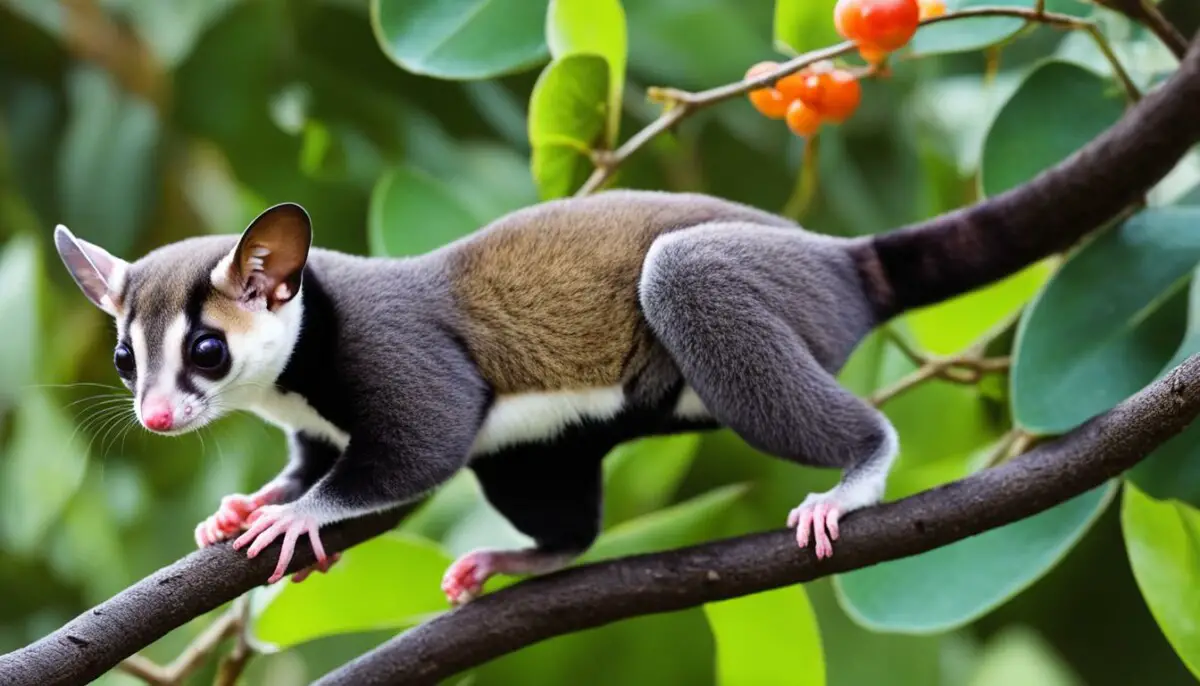

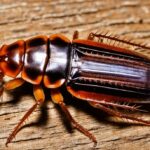
.jpg)



